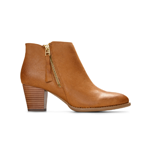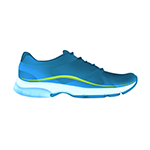
Strategies on How to Ease Arthritis Pain Effectively

Struggling to stand after your legs get stiff, skipping your daily walk, or dealing with sleepless nights because of aches and pains—these can all be realities for people living with arthritis.
Wondering how to ease arthritis pain? Luckily, you have numerous options (both medical and more holistic treatment approaches). However, many arthritis patients find the most relief in long-term, consistent lifestyle adjustments: tactics like exercising, improving their posture and gait, and prioritizing rest.
Especially for people living with foot and leg arthritis, footwear selection can help with pain management and improve day-to-day life, too. We’ll touch on what to look for in arthritis-friendly footwear and flesh out the concepts above in this comprehensive guide.
Overview of Arthritis Pain Relief Methods
For people living with arthritis (chronic joint inflammation), treatments have four main goals:
- Relieving pain – Joint inflammation can lead to joint pain—and this pain can disrupt your regular activities and decrease your quality of life. So, reducing overall pain is a typical arthritis treatment for those who are suffering.
- Improving joint function – Unfortunately, you can’t replace joint tissues once they’re damaged beyond repair. However, you can optimize the joint tissues you still have and help them function at their best. Prioritize improving joint function if you suffer from sore joints.
- Preventing arthritis progression – While you may not be able to completely stop the progression of some forms of arthritis (like osteoarthritis, a degenerative condition), you can slow down the progression of joint damage.
- Maintaining quality of life – Arthritis is hard on your body—and on your lifestyle. The different arthritis treatment options are designed to improve your overall quality of life and help you maintain a normal routine.
Medical Treatments vs. Natural Remedies for Arthritis
Learning how to ease arthritis knee pain (or arthritic pain anywhere in your body) is all about relieving your pain, optimizing your joint function, slowing the progression of the condition, and stabilizing your quality of life. Both conventional medical interventions and more holistic, natural remedies can support these goals in treating knee arthritis.
Medical Interventions
If you see a doctor about your arthritis symptoms, they’ll likely use one or more of the following methods to help relieve your symptoms:
- Physical therapy – By promoting low-intensity exercises for arthritis, providers can help you boost overall muscle strength and flexibility which can help optimize your joint function and improve your quality of life.
- Medications – Prescription drugs can help reduce pain in the affected joint, manage inflammation, and lubricate your joints (which helps them move with less resistance). Wondering how to ease rheumatoid arthritis pain with medications? Since rheumatoid arthritis is an autoimmune disease, healthcare providers may treat it with drugs that suppress the immune system.
- Surgery – If you have a very severe case of arthritis that significantly interferes with your mobility, providers may recommend surgery to either remove parts of your bone (a procedure called an osteotomy) or replace your arthritic joint tissue with artificial materials (like plastic, metal, or ceramic).
While all of these options have benefits (primarily relief from chronic pain and other symptoms), they can take time to kick in and vary in invasiveness.
Holistic Options
If you’re looking for a natural remedy instead of a medical procedure to relieve arthritis pain, consider:
- Topicals – Many patients report that topical creams and lotions containing natural ingredients like capsaicin and arnica help relieve joint pain.
- Heat – You can also soothe sore or aching joints with heat: soaking in a warm bath, using a warm compress, or warming up a hot water bottle.
- Low-impact fitness – Low-intensity fitness activities like yoga and tai chi can help you strengthen muscles and improve functional strength outside of the physical therapy suite.
While remedies like these can offer relief, they may not offer a permanent solution to your arthritis symptoms. Conventional medical interventions (especially arthritic joint replacement surgeries) offer a high success rate and long-term relief.
Lifestyle Adjustments for Reducing Arthritis Pain
Whether you opt for conventional medical treatments, holistic options, or a combination of both, your care team may also recommend complementary lifestyle adjustments that could help you manage arthritis pain.
Keep Moving
Many experts recommend low-intensity, consistent exercise for relieving arthritis pain. Why?
- Regular physical activity can help keep the muscles around your joints strong, relieving some of the pressure on your joints during normal movement.
- Physical activity can also increase your stamina (i.e., how long you can walk or stand before resting) and improve your sleep—both of which can promote overall quality of life improvements.
- Exercise has undeniably positive impacts on cardiovascular health; for people living with arthritis (and, thus, facing the risks of a sedentary lifestyle), these cardiovascular benefits are particularly important.
Some popular exercise options for people with arthritis pain are:
- Cycling
- Swimming or water aerobics
- Yoga
- Leisurely walks
- Yard work and cleaning
Focus on Posture and Gait
The ways you sit, stand, and walk can all affect your arthritis pain. Posture and gait impact the ways in which you use your joints, muscles, and bones—how much pressure you put on each joint and when.
Here are a few tactics for improving your posture and gait for better pain management:
- Focus on keeping a straight spine and relaxed shoulders while sitting.
- Sit with your feet flat on the ground and your knees at ninety-degree angles.
- Hinge at the waist to bend over instead of arching your back.
- Keep your feet and legs hip-width apart while walking.
- Focus on taking even, level steps and getting full contact with the ground on each step.
- Adjust your car seats to provide more lumbar and neck support.
In addition, you might be able to improve your posture and gait with tools like:
- Orthotic insoles – Orthotic insoles can help support your feet and legs while walking to promote overall posture and gait improvements.
- Supportive shoes – Shoes for heel pain, arthritis support, and ankle stability are uniquely designed to cup your feet and provide a stable platform for movement.
- Mobility aids – Canes and walkers can help you relieve joint pressure if you’ve developed a limp or have trouble using both legs equally while walking.
Rest and Recover
Whether you’re in the gym every day or taking a more laid-back approach to arthritis relief, recovery and rest are especially important as you seek to relieve pain.
Researchers have already identified numerous links between sleep quality and chronic pain—the long-term pain many people with arthritis experience. So, improving your overall sleep hygiene could help with pain management over time.
Even when you’re relaxing at home, don’t forget to use the tools available to help relieve pain: even comfy slippers can offer support and comfort during recovery time.
Importance of Choosing the Right Footwear for Pain Relief
Speaking of footwear, there’s no denying the link between high-quality, supportive footwear and arthritis pain relief. In fact, choosing the best footwear for arthritic feet is paramount, especially if you’re looking to maintain an active lifestyle, improve your gait, or recover in comfort.
So, what should you look for in your search for the perfect shoe for arthritis? Let’s dive into some must-have features.
Arch Support
Women’s arch support shoes and Men’s arch support shoes are widely available in today’s market—but what makes them different from typical shoes?
- Contact – Shoes with exceptional arch support like our Walk Max Lace Up Sneaker are designed to contact your full arch at both its highest and lowest points.
- Firmness – Arch support shoes feature firm (yet comfortable) foams and other materials that help you maintain stability and a proper gait.
- Pronation prevention – By maintaining full contact with your arch, the firm materials used in arch support shoes keep you from pronating (or “falling in” on your arches) while walking.
All of the above features are important for people living with arthritis—especially arthritis in the legs and feet. Shoes with arch support can improve your comfort and help relieve pain during everyday activities, exercise, and relaxing moments at home.
Stability
Arch support is just one feature of arthritis-friendly sandals and shoes, such as the Bella II Toe-Post Sandal, which promotes overall stability. This stability is a must for people looking to stay active while living with arthritis; a shoe that firmly encases your feet and supports each step can help you maintain a normal gait and move confidently in the face of arthritis pain.
In addition to arch support, shoes that offer ample stability also normally include:
- Deep heel cups – Just like quality insoles come in contact with your entire arch, quality heel cups, like those found in our Uptown Loafer, come in contact with your entire heel. Since you put a lot of pressure on your heels when you walk, supporting overall stability in this part of your foot is key.
- High sidewalls – Sidewalls help keep your feet stable and aligned inside your shoe (whether you’re walking through the mall or hiking a trail). The higher the sidewall, the higher the stability.
Cushioning
While supportive features are made from firm foams and other hardy materials, your shoes should also absorb shock, help keep a spring in your step, and promote overall comfort—that’s where cushioning comes in.
Cushioning features in shoes help you feel like you’re not walking in wooden clogs; while you need hard materials like wood and metal to provide support for your feet, you also need softer materials to protect your joints from impact.
So, finding the perfect shoes for arthritis is all about balancing support and cushioning to support sore joints.
Support an Active Lifestyle with Vionic
Easing arthritis pain comes down to building functional strength, preventing further joint injury, and finding ways to improve your quality of life. And when you’re looking for the perfect shoes to help you accomplish all of these, Vionic has you covered.
We offer stylish, yet comfortable sneakers, business casual pairs, women’s recovery shoes, men’s recovery shoes, and so much more. Plus, we combine the best in comfort technologies with today’s most popular styles and materials to create footwear for every look.
Check out our entire catalog to find your next pair of arthritis-friendly shoes.
Sources:
National Institute of Arthritis and Musculoskeletal and Skin Diseases. Arthritis. https://www.niams.nih.gov/health-topics/arthritis
National Institute of Arthritis and Musculoskeletal and Skin Diseases. Osteoarthritis: Diagnosis, Treatment, and Steps to Take. https://www.niams.nih.gov/health-topics/osteoarthritis/diagnosis-treatment-and-steps-to-take
National Institute of Arthritis and Musculoskeletal and Skin Diseases. Rheumatoid Arthritis: Diagnosis, Treatment, and Steps to Take. https://www.niams.nih.gov/health-topics/rheumatoid-arthritis/diagnosis-treatment-and-steps-to-take
Arthritis Foundation. 5 Ways to Take Herbs and Supplements for Arthritis. https://www.arthritis.org/health-wellness/treatment/complementary-therapies/supplements-and-vitamins/5-ways-to-take-herbs-and-supplements-for-arthritis
Arthritis Foundation. Heat Therapy Helps Relax Stiff Joints. https://www.arthritis.org/health-wellness/healthy-living/managing-pain/pain-relief-solutions/heat-therapy-helps-relax-stiff-joints
Sunnyvale Sports Medicine and Orthopedic Center. How Successful Is Joint Replacement Surgery?. https://sunnyvaleorthopedics.com/how-successful-is-joint-replacement-surgery/
Johns Hopkins Arthritis Center. Role of WExercise in Arthritis Management. https://www.hopkinsarthritis.org/patient-corner/disease-management/role-of-exercise-in-arthritis-management/
Arthritis Foundation. Can Changing the Way You Walk Help Osteoarthritis Pain?. https://www.arthritis.org/health-wellness/treatment/treatment-plan/disease-management/changing-gait-for-knee-osteoarthritis
Journal of Bone and Mineral Research. The Importance of Sleep for People with Chronic Pain: Current Insights and Evidence. https://www.ncbi.nlm.nih.gov/pmc/articles/PMC9289983/
Arthritis Foundation. A Guide to the Best Shoes for Arthritis. https://www.arthritis.org/health-wellness/healthy-living/daily-living/life-hacks-tips/arthritis-shoe-guide









